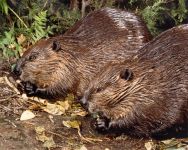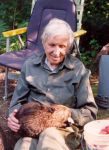


|

|
|
 
|
A true tale of wildlife in the woods, by Hope Sawyer Buyukmihci, 1966
Published in the July 2011 issue of The Beaver Defenders
Whiskers and Greenbrier are two beavers who live deep in our South Jersey wildlife refuge. I first met them three years ago.
I spotted Whiskers first, one daybreak while I was trimming a trail along the creek. Unaware of me, she wriggled though the branches of a fallen cedar, swam along a half submerged log and came to the dam near me. She placed a stick in the dam, then turned and disappeared into the bushes.
An idea grabbed me. In the main pond I'd never been able to get within 200 yards of a beaver. Perhaps, in the seclusion of the forest, we could become friends.
Beginning a campaign to lure her with food, I put an armful of fresh poplar limbs on the dam. Next day they were gone, except for a few peeled lengths floating in the stream. From then on, I kept the place stocked with poplar branches.
July passed into August, and Whiskers came daily, sometimes when I was there. One evening, she swam to where my two daughters and I sat at the end of the dam. Approaching to within two feet of me, she took a stick from my hand. I spoke to her. She didn't mind. One of the girls fed her a twig. While she was eating, we were surprised to hear another beaver splash, far upstream. I had thought she lived alone. I named the second one – a male and much shyer – Greenbrier.
One October twilight I stood in the middle of the dam as Whiskers approached from downstream. I called to her and she came toward me. About three feet away, and partially screened by a group of sweet pepper bushes, she began to talk to me in a plaintive, questioning murmur. After several remarks, she rounded the hummock and started nibbling a cluster of poplar leaves at my feet. At last, we were friends.
Winter came, and the beavers no longer appeared. But when the song sparrows began singing in the brush and the pond rang with a chorus of early redwings, they returned.
Greenbrier was still shy, but Whiskers grew chummy enough to sit on the dam beside me and comb her fur. I talked to her, and she listed gravely, now and then murmuring softly in reply.
The last part of May, Whiskers didn't come to eat. For a week I was worried, but then she was back – a new gleam in her eye. I wondered how many kittens she had, and if I would ever see them. Certainly she wouldn't bring them to me – not during their first few weeks of life. I decided to go to them.
The old beaver lodge was dry and deserted but, downstream, I saw a brand-new one chinked and plastered with fresh mud. From inside came the frenzied mewing of beaver kittens. Then, while I sat in polite silence on the root of a big cedar tree, two young beavers popped out. They swam around awkwardly, tipping from sided to side, their fur fluffy and buoyant. They looked less than a foot long, with tiny paddle tails.
Then Greenbrier, the father, arrived and began work on his lodge. With his mouth he towed a stick, diving along the way to gather a big armload of mud. Rising on his hind feet, he stalked up the steep side of the lodge, carrying the mud in his arms, the stick trailing from his mouth. I watched him for an hour or more, while the sky darkened and the moon shone.
He often stopped for refreshment felling small ilex stems and alder bushes, from which he ate berries and leaves, working the leavings into his lodge.
Evidently construction was far from finished, for he labored day after day, often at noon, usually building up one side at a time. A favorite material was old cedar roots from the bottom of the creek.
Equipped with furry folds which may be closed behind his cutting teeth, a beaver can gnaw comfortably while submerged. And he can hold his breath for 10 minutes or more. The rasp of Greenbrier's teeth came muffled and hollow as he gnawed at he underwater roots.
One evening four young beavers came out. Three wore conventional dark brown. The fourth had honey-blonde fur –I named her Goldy. The kits were about a month old by then., still awkward, and hesitant in their movements. They ate clumsily, holding poplar twigs in delicate hands, tussling over disputed sticks with vexed whines. Sometimes one would drop his twig, then examine empty hands in a puzzled manner.
The mother often joined them, and they greeted her with eager whines. She liked to cuddle one in her arms and roll over and over in the water. Sometimes one of the young beavers climbed onto her back and took a brief ride on her tail.
Whiskers taught mostly by example, but on occasions she admonished them with a sharp hiss. Both she and her brood talked together in soft murmurs and whines. The little ones' voices became strident only when disputing ownership of a stick. They loved to roll floating logs, nudging them along with a nose-push as well as deft paws. They engaged in many a wrestling bout, both in the water and out.

Before the summer had passed, the boldest, whom I had named Fluffy, would paddle up to the dam, clamber over and make straight for my bonanza of poplar branches – while I held him in my lap and scratched behind his ears. Sometimes at dusk, all four youngsters would line up on the dam beside me to comb their fur, and often their mother joined them.
Meanwhile, a drought was having drastic effects on our stream. No rain came and the water level dropped steadily. By the first of September the beavers were wallowing through mud to get to the dam. Suddenly, they stopped coming.
I walked three or four miles up the dry stream bed, looking for them, past old beaver works long since destroyed, and isolated pools of stagnant mud. Broken dams had let the water rush away in flood time, and piles of dry branches showed where ancient food rafts were crumbling away, never eaten by the thrifty ones who had stored them.
The beavers were gone, and with them the drought insurance they had once so aptly provided. No wonder our big pond was dry, with the ghost of a channel winding through it. I returned home much disturbed. Where was Whiskers and her family?
Then, below the main dam at the pond, I suddenly found fresh mud plastered on an old beaver lodge. And one afternoon I saw a little blonde beaver swimming in a quiet pool. It was Goldy. I tendered her a willow branch, but she edged away, so I left. In an hour, I tip-toed back to find her eating. She soon became friendly as ever. A few days later the whole family was assembled to partake of my bounty.
I took up beaver-watching again, and one afternoon I made a trip downstream to discover how the water was holding out. There had been only a few sprinkles of rain and the upcreek and main pond were still dry.
Below, all was different. A series of small new dams cut the creek at intervals of about 100 feet, and each held back its share of water in a generous pool. All along the bank on each side gleamed new-cut stumps. Piles of white sticks showed the teeth marks of Whiskers an her clan. For nearly a mile, there was an abundance of water, conserved though sky-water hadn't come.
In one of the pools, Fluffy appeared, swimming beside me. He circled in the water, regarding me with interest. "Hi!" I called. "You're doing a great job." And I left the stream to his care.